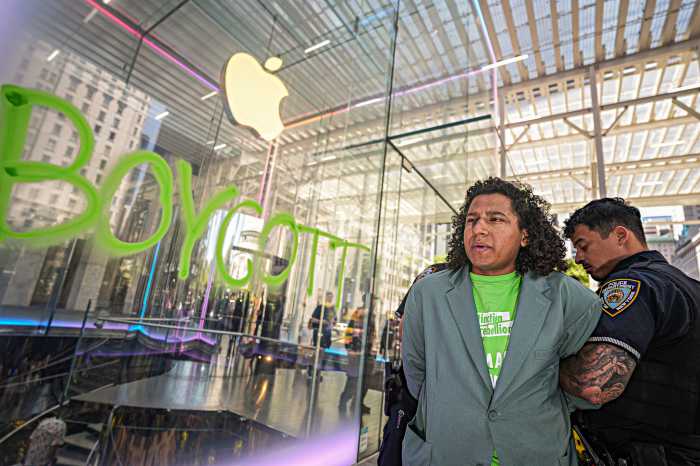By Suzanne Parker
Once ingested, it stays in your blood (and I'm not talkin' about the cholesterol.) That's what happened to Travis Mills. His six years spent studying at the University of Texas, Austin, left its indelible gastronomic mark. He moved to New York City, but never stopped jonesing for smoky, slow-cooked animal protein. Commiserating with friend Cathryn Rich on their common craving spawned an idea. Why not bring real barbecue to New York City? The idea coalesced into a barbecue event to be held annually at a site in New York City. They called it “BBQ-NYC.” Real barbecue is not what happens when you slap a steak on your backyard Weber. Tasty as it might be, that's grilling. True Ôcue involves slow-cooking seasoned meat over carefully controlled indirect heat fueled by wood, not charcoal or gas. To do this, you need someone with both the right equipment and the expertise.Travis Mills put out an urgent plea on an online message board for Ôcue devotees called “bbqforum.com” for someone with the right stuff. His call was answered by Big Island Bar-B-Que, a family of Ôcueheads from Rego Park.Big Island Bar-B-Que is the brainchild of the Richter brothers. Dr. Michael Richter is a physician in practice with his father, Dr. Sam Richter, in Rego Park, and brother Robert Richter is the office manager. In their barbecue personas, Robert is the pit boss, and Michael is the desserts and sides man. Michael also slices, with surgical precision.The Richters' 17-foot custom barbecue rig, fabricated in Louisiana, has wheels and it travels. Their barbecumania has taken them to competitions in the Northeast and beyond and bagged many awards in the process. They also operate a BBQ catering business that offers a spectrum of barbecue styles and harmonizing comestibles. Having found a barbecuing team, Mills' next task was to secure a venue. The inaugural event took place on Wards Island in 2003. This year's feast, limited to 250 revelers, was held at Flushing Meadows Corona Park. He promoted it only on his BBQ-NYC Web site and by word of mouth. He charged $25 per person Ñ only to cover costs. The news ricocheted around foodie message boards, and within about a week it was sold out.On July 24, the day of the big event, the skies were overcast and showers and thunderstorms were predicted, but the threatening weather deterred none of the zealots. The faithful represented an interesting cross-section of society, the only common denominator a reverence for properly prepared Ôcue. I randomly joined a table that seated a psychologist, a producer for WNYC (not there in a professional capacity), a techie and a caretaker from a local historic house. The techie at our table was an ex-Texan.The Ôcue was sensational. The brisket matched or surpassed most of what I have eaten in the barbecue shrines of Texas. The meat was succulent, melt-in-your-mouth tender, piquant and devoid of any visible fat. Other meats served were pulled pork, chicken, and bratwurst Ñ all exceptional. Robert Richter confided that his special technique is a hybrid of a judicious use of both dry rubs and sauce. The dividing line distinguishing regional styles of Ôcue is demarcated by meat preferences and the flavors of the sauce. Texans like beef, and sauces with intense chili pepper heat. Kansas City, considered by some to be the center of the barbecue universe, is known for its ribs and sweet tomatoey sauces. In the Carolinas pork prevails, with a vinegar-based sauce in the northern and eastern regions, and a sweet, mustardy sauce to the south. Floridians add citrus or tropical fruits to their sauce. Examples of several sauces were on the table so that diners could slather their Ôcue with the essences they favor.Incidentals included the traditional coleslaw, potato salad, beans, corn, and white bread, supplemented by potluck dishes brought by participants. Steve Silverberg brought several sides of salmon soaked in a honeyed brine and smoked over alder in his Queens backyard. Beer was provided by artisanal micro-brewery Dogfish Ale. My accomplice, a beer maven, immediately recognized it as suds he'd imbibed at Baltimore Orioles games. He was right on the money, because Dogfish is based in Milton, Dela., and purveys its brews at the ballfield. BBQ-NYC featured two of its most popular ales. Sixty Minute IPA (India Pale Ale), its signature brew, made by adding hops once per minute for an hour, has a hoppy aroma, but avoids bitterness by this prolonged process. Shelter Pale Ale was also on tap. The beer was drawn quietly under the table into big red soda cups. Shhhh Ñ don't tell Estelle Cooper.If you are sorry you missed this event, track www.bbq-nyc.com. Travis Mills will soon be posting pictures and observations about this year's event. When the time comes, he will post information about participation for next year. Travis Mills's dream for the future is to have a BBQ-NYC barbecue competition. Let's hope he keeps it in Queens.Suzanne Parker is the TimesLedger's restaurant critic, and author of “Eating Like Queens,” a guide to the borough's gastronomic adventures to be published by Jones Press, in spring 2005. E-mail her at qnsfoodie@aol.com.































